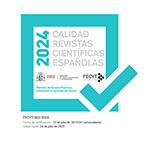Louise Bourgeois and the modernist canon in Art History: Alternatives from feminist criticism
Abstract
Louise Bourgeois began her artistic career in New York in the 1940s as a colleague of the abstract expressionists, whose artwork was hailed by Clement Greenberg as a high point in modernist abstraction. Bourgeois’ peculiar position –poised between two seemingly opposed art movements, surrealism and abstract expressionism and feminism- has created a conundrum for critics. As art historians have increasingly begun to blur the boundaries separating modernism from feminism, however, Bourgeois’ art has acquired fresh urgency. In this paper we suggest that Bourgeois’ artistic oeuvre elaborated avant-garde tropes for the unconscious and for women in order to posit a complex female subjectivity and to challenge the simplistic identification of irrationality with femininity. We also provide a critical approach to her installation “Precious Liquids” (1992) in the midst of feminist art historical debates around the metaphorical potential of the body drawing from the painted traces of the abstract expressionists and from the artist’s own previous rubber and stone sculptures.Downloads
Article download
License
In order to support the global exchange of knowledge, the journal Investigaciones Feministas is allowing unrestricted access to its content as from its publication in this electronic edition, and as such it is an open-access journal. The originals published in this journal are the property of the Complutense University of Madrid and any reproduction thereof in full or in part must cite the source. All content is distributed under a Creative Commons Attribution 4.0 use and distribution licence (CC BY 4.0). This circumstance must be expressly stated in these terms where necessary. You can view the summary and the complete legal text of the licence.











